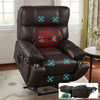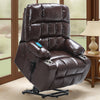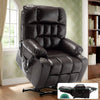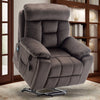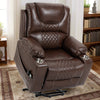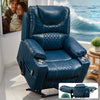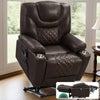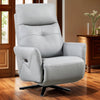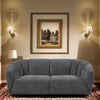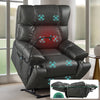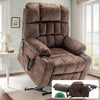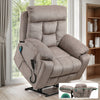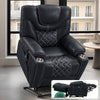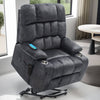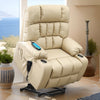The Power Lift Recliner: A Game-Changer for Elderly Mobility
Understanding the Mechanism of Power Lift Recliners
Power lift recliners are innovative chairs designed to help seniors stand up and sit down easily. They use electric motors to tilt and lift the chair. This feature is a big help for those with mobility issues.

The chair's mechanism is simple yet effective. At the push of a button, the chair slowly rises and tilts forward. This motion gently assists the user to a standing position. It also works in reverse, helping seniors sit down safely.
These recliners often have other features too. Many include heat and massage options for extra comfort. Some have USB ports for charging devices. The controls are usually simple and easy to use, even for those with limited dexterity.
The Impact of Power Lift Recliners on Senior Accessibility
Power lift recliners have greatly improved daily life for many seniors. They offer independence and safety in a simple piece of furniture. For those who struggle to stand or sit, these chairs are a game-changer.
The benefits go beyond just standing and sitting. These chairs can help reduce the risk of falls. They also lessen the strain on caregivers who assist with transfers. This can lead to fewer injuries for both seniors and their helpers.
Many seniors report feeling more confident with a power lift recliner. They can move around their home more freely. This increased mobility often leads to better overall health and mood. It's a simple change that can have a big impact on quality of life.
Integrating Power Lift Recliners into Home Healthcare Strategies
Evaluating the Cost-Benefit of Power Lift Recliners for Senior Care
When considering a power lift recliner, it's important to look at both costs and benefits. These chairs can be more expensive than standard recliners. However, they offer value that goes beyond the price tag.

The initial cost may seem high, but it's important to consider long-term savings. These chairs can:
- Reduce the need for in-home care
- Lower the risk of fall-related injuries
- Decrease strain on family caregivers
- Improve overall quality of life
Many insurance plans, including Medicare, may cover part of the cost. This can make power lift recliners more affordable for many seniors. It's worth checking with insurance providers to see what options are available.
In the long run, the benefits often outweigh the costs. The improved mobility and independence can lead to better health outcomes. This can mean fewer doctor visits and less need for other medical equipment.
Strategies for Implementing Power Lift Recliners in Home Care Settings
Adding a power lift recliner to a home care plan requires some thought and planning. Here are some strategies to make the most of these chairs:
- Assess the living space: Make sure there's enough room for the chair to fully recline and lift.
- Consider the user's needs: Choose a chair with features that match the senior's specific needs.
- Provide proper training: Ensure the user and caregivers know how to operate the chair safely.
- Regular maintenance: Keep the chair in good working order to prevent issues.
It's also important to integrate the chair into daily routines. Encourage regular use to maintain muscle strength and flexibility. The chair can be a tool for gentle exercises, even for those with limited mobility.
Working with healthcare providers can help create a plan that includes the power lift recliner. They can offer advice on how to use the chair as part of a broader care strategy. This might include physical therapy exercises or fall prevention techniques.
Regulatory and Safety Considerations for Power Lift Recliners in the United States
Navigating the Regulatory Landscape for Power Lift Recliners
In the United States, power lift recliners are considered medical devices. This means they are regulated by the Food and Drug Administration (FDA). Manufacturers must follow specific guidelines to ensure safety and effectiveness.

The FDA classifies these chairs as Class II medical devices. This puts them in the same category as wheelchairs and walkers. Manufacturers must register with the FDA and follow quality control standards. They also need to report any adverse events or malfunctions.
For consumers, this regulation offers some assurance of safety and quality. When shopping for a power lift recliner, look for FDA approval. This shows the chair meets necessary safety standards. It's also a good idea to check for any recalls or safety alerts before making a purchase.
Some states may have additional regulations for medical devices used in home care. It's worth checking local laws to ensure compliance. This is especially important for caregivers or facilities providing these chairs to seniors.
Best Practices for Ensuring the Safety of Elderly Users
Safety is a top priority when using power lift recliners. Here are some best practices to keep in mind:
- Read the manual: Understand all features and safety precautions before use.
- Clear the area: Make sure there's nothing in the way when the chair lifts or reclines.
- Regular checks: Inspect the chair often for any signs of wear or damage.
- Use as directed: Don't exceed weight limits or use the chair for unintended purposes.
- Keep it dry: Avoid spills and keep the electrical components away from water.
It's also important to consider the user's physical condition. Some seniors may need supervision when using the chair. Others might benefit from additional safety features like side rails or emergency stop buttons.
Caregivers should be trained on how to help seniors use the chair safely. This includes knowing how to operate the controls and assist with transfers. Regular practice can help both the user and caregiver feel more confident.
Remember, while power lift recliners can greatly enhance mobility, they're not a substitute for medical care. Always consult with healthcare providers about any mobility concerns or changes in condition. With proper use and care, these chairs can be a valuable tool in senior care and independence.








